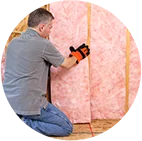Although this may seem like a simple, straightforward question, there is no one-size-fits-all solution to insulation installation – it depends on a few different factors! The amount of insulation you install will depend on:
- The age of your home
- Where you live
- The type of heating and cooling system you have
- The areas of your home you need to insulate
- The framing of your house
First things first – it’s a good idea to check how much insulation you currently have, which a professional insulation company like OJ Insulation will be able to help you with. In general, you should check:
Behind the walls: an easy way to do this is by looking behind the electrical outlet. First, TURN OFF THE POWER to the outlet (make sure you do this from the circuit breaker so you can ensure there’s no power flowing to it), then remove the cover plate and shine a flashlight inside to take a quick peek. You should be able to see some insulation. Also be sure to check outlets on both the first and second story of your home.
The ductwork: if you can see your ducts, make sure they are insulated. Ducts need to be insulated, particularly if they run through unconditioned areas (attics, crawl spaces, etc.). You should be able to tell fairly easily if your ducts aren’t insulated – insulated ducts usually are completely covered by shiny foil duct wrap insulation.
Under the floors: in an unheated space, try to look under the flooring if you can (a crawl space is a good area to do this). There should be some insulation. If there isn’t, or there’s just a very thin layer, you could benefit from more insulation, not just in terms of how energy-efficient your home is but also how comfortable it is!
How Much to Insulate
As mentioned, several different factors determine how much insulation you’ll need to install:
Age of your home: generally speaking, older homes tend to need more insulation. If your home was built in the 1970s or earlier, chances are you don’t have enough insulation. Re-insulating can save you hundreds of dollars a year, make your home more comfortable, and reduce noises from outside as well as between different rooms and levels inside your house.
Where you live: this is one of the biggest factors. Typically, colder regions like the Northeast need more insulation. According to NAIMA’s map based on recommendations from the DOE and IECC, we are in zone 3 here in Southern California. To give you a quick breakdown:
| Heating System | Attic | Wall Cavity | Flooring |
| Gas, oil, heat pump | R30 to R60 | R13 to R15 (no sheathing) | R25 |
| Electric furnace | R30 to R60 | R13 to R15 (R2.5 to R5 for sheathing) | R25 |
Type of HVAC system you have: as you can see in the above table, the HVAC system you have is related to how much insulation you’ll need to install. It’s best to talk to professional insulation contractors about your HVAC equipment and insulation requirements.
Areas of your home you need to insulate: where you’re insulating will dictate which type of insulation you’ll use and the amount needed. Radiant barrier attic insulation, for example, has different R-value and thickness requirements than a fiberglass blanket system.
Framing of your home: more heat flows through metal joists and studs than wood ones, so insulating between wall studs or between attic or floor joists doesn’t work as well for houses with metal frames.
If you’re ready to start your insulation project and need insulation contractors, contact OJ Insulation today!









